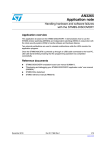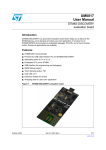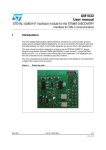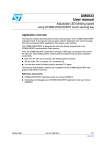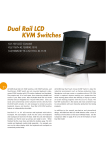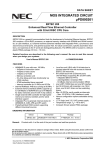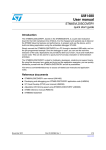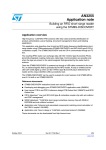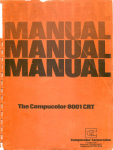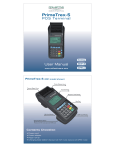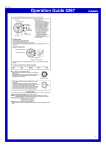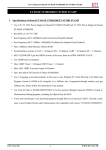Download Using the STM8S-DISCOVERY GPIOs and interrupt controller to
Transcript
AN3266 Application note Using the STM8S-DISCOVERY GPIOs and interrupt controller to drive LEDs Application overview This application is based on the STM8S-DISCOVERY. It demonstrates how to use the STM8S GPIOs and interrupt controller to drive a set of LEDs. Once the STM8S105C6T6 is powered up through an USB cable connected to the host PC, LEDS LD2 and LD5 start blinking meaning that the programming operation has completed successfully. Each time the pushbutton is pressed, the interrupt controller asserts an interrupt that is used to control the I/Os, and change the LED behavior. Reference documents ■ STM8S-DISCOVERY evaluation board user manual (UM0817). ■ Developing and debugging your STM8S-DISCOVERY application code user manual (UM0834). November 2010 Doc ID 17876 Rev 1 1/11 www.st.com Contents AN3266 Contents 1 2 Application description . . . . . . . . . . . . . . . . . . . . . . . . . . . . . . . . . . . . . . 5 1.1 Hardware requirements . . . . . . . . . . . . . . . . . . . . . . . . . . . . . . . . . . . . . . . 5 1.2 Application schematics . . . . . . . . . . . . . . . . . . . . . . . . . . . . . . . . . . . . . . . . 5 1.3 Application principle . . . . . . . . . . . . . . . . . . . . . . . . . . . . . . . . . . . . . . . . . . 6 Software description . . . . . . . . . . . . . . . . . . . . . . . . . . . . . . . . . . . . . . . . . 7 2.1 3 2/11 STM8S peripheral configuration . . . . . . . . . . . . . . . . . . . . . . . . . . . . . . . . . 7 2.1.1 GPIOs . . . . . . . . . . . . . . . . . . . . . . . . . . . . . . . . . . . . . . . . . . . . . . . . . . . 7 2.1.2 EXTI . . . . . . . . . . . . . . . . . . . . . . . . . . . . . . . . . . . . . . . . . . . . . . . . . . . . . 7 2.2 Standard STM8S standard firmware library configuration . . . . . . . . . . . . . 7 2.3 Application software flowchart . . . . . . . . . . . . . . . . . . . . . . . . . . . . . . . . . . 7 2.3.1 Main loop flowchart . . . . . . . . . . . . . . . . . . . . . . . . . . . . . . . . . . . . . . . . . 7 2.3.2 Interrupt function flowchart . . . . . . . . . . . . . . . . . . . . . . . . . . . . . . . . . . . 9 Revision history . . . . . . . . . . . . . . . . . . . . . . . . . . . . . . . . . . . . . . . . . . . 10 Doc ID 17876 Rev 1 AN3266 List of tables List of tables Table 1. Table 2. Table 3. List of external components . . . . . . . . . . . . . . . . . . . . . . . . . . . . . . . . . . . . . . . . . . . . . . . . . 5 LEDs configuration . . . . . . . . . . . . . . . . . . . . . . . . . . . . . . . . . . . . . . . . . . . . . . . . . . . . . . . . 6 Document revision history . . . . . . . . . . . . . . . . . . . . . . . . . . . . . . . . . . . . . . . . . . . . . . . . . 10 Doc ID 17876 Rev 1 3/11 List of figures AN3266 List of figures Figure 1. Figure 2. Figure 3. 4/11 Application schematics . . . . . . . . . . . . . . . . . . . . . . . . . . . . . . . . . . . . . . . . . . . . . . . . . . . . . 6 Main loop flowchart . . . . . . . . . . . . . . . . . . . . . . . . . . . . . . . . . . . . . . . . . . . . . . . . . . . . . . . . 8 EXTI_PORTB_IRQhandler() function flowchart . . . . . . . . . . . . . . . . . . . . . . . . . . . . . . . . . . 9 Doc ID 17876 Rev 1 AN3266 Application description 1 Application description 1.1 Hardware requirements No on-board resources are required. Table 1 gives the list of external components required by the application. Table 1. 1.2 List of external components External components Value Comments LD2, LD3, LD4, LD5 - Standards LEDs R2, R3, R4, R5 510 Ω Protective resistors R1 4.7 kΩ Pull-up resistor R 100 Ω C 100 nF Pushbutton - Debounce filter Standard pushbutton Application schematics Figure 1 shows how to interface the LEDs and the pushbutton with the STM8SDISCOVERY. For details on STM8S-DISCOVERY implementation, refer to the board schematics provided in the STM8S-DISCOVERY user manual (UM0817). Protective resistors, R2, R3, R4, and R5, are mandatory to limit the current to a value that does not harm the LEDs. The pushbutton requires a debounce filter (RC) and a pull-up resistor (R1) to avoid triggering several interrupts due to the mechanical bouncing of the button. Doc ID 17876 Rev 1 5/11 Application description Figure 1. AN3266 Application schematics 6$$ 2 ªª 34-3 ªªª 0" # 0" 0" 0" 0" 2 2 2 2 ,$ ,$ ,$ ,$ 2 0USHBUTTON ªª AI 1.3 Application principle At startup, LD2 and LD5 start blinking meaning that the STM8S105C6T6 Flash memory has been successfully programmed. Pressing the pushbutton generates an interrupt which is handled by the application software to drive the LEDs. Only one of the two pairs of LEDs, LD2/LD5 and LD3/LD4 blink at a time. A button event triggers the blinking of the other pair while switching off the first one. The LEDs blinking conditions are described in Table 2. Table 2. LEDs configuration Application At startup On button event 6/11 LED state LD2 and LD5 blink The blinking LED pairs are swapped Doc ID 17876 Rev 1 AN3266 2 Software description Software description The application software uses STM8S standard firmware library to control the general purpose features described in Section 2.1. 2.1 STM8S peripheral configuration 2.1.1 GPIOs The application drives the MCU I/Os to interface the microcontroller with external hardware components. The GPIO_Init() function configures PB0 as floating input with interrupt to detect pushbutton events, and PB1/PB2/PB3/PB4 as output push-pull to control the LEDs. 2.1.2 EXTI The external interrupt controller is configured through the EXTI_SetExtIntSensitivity() function to handle the external interrupts on PB0. The external interrupt sensitivity is configured to trigger an interrupt each time a falling edge, and only a falling edge, is detected on PB0. 2.2 Standard STM8S standard firmware library configuration The stm8s_conf.h file of the STM8S standard firmware library is used to configure the library by enabling the peripheral functions used by the application. The following define statements must be present: #define _GPIO 1 /* enables the GPIOs */ #define _EXTI 1 /* enables the EXTI */ 2.3 Application software flowchart 2.3.1 Main loop flowchart The code main loop implements the algorithm that controls the LEDs according to pushbutton events. The blinking LED pair is selected by setting the ButtonState flag. Each time the pushbutton is pressed, an interrupt is triggered and ButtonState is complemented (see Section 2.3.2: Interrupt function flowchart). The main loop code tests ButtonState and selects the blinking LED pair according to its value (see Table 2). The Delay() function generates a delay between the LED ON and OFF states so that we can see them blink. Figure 2 shows the flowchart of the application software main loop. Doc ID 17876 Rev 1 7/11 Software description Figure 2. AN3266 Main loop flowchart 3TART '0)/#ONFIGURATION #ONFIGURES0"0"0"0"ASOUTPUTPUSHPULLLOWTODRIVES,$ ,$,$AND,$ #ONFIGURES0"ASFLOATINGINPUTWITHINTERRUPTSTOHANDLETHEPUSHBUTTON %84)#ONFIGURATION #ONFIGURESTHEEXTERNALINTERRUPTSENSITIVITYTOFALLINGEDGEONLYON0" 4HISFUNCTIONCALLENABLESALLTHE34-3INTERRUPTIONS ENABLE)NTERRUPTS "UTTON3TATE .O 9ES 3ELECT,%$S,$,$ 3ELECT,%$S,$,$ 4HESELECTED,%$PAIRSTARTSBLINKING UNTILTHEBUTTONISPRESSEDAGAIN 3WITCH,%$S/. $ELAY 3WITCH,%$S/&& AI 8/11 Doc ID 17876 Rev 1 AN3266 2.3.2 Software description Interrupt function flowchart Each time an interrupt is asserted, the EXTI_PORTB_IRQhandler() function complements the ButtonState flag and the main loop behaves accordingly (see Table 2). Figure 3 shows the flowchart of the EXTI_PORTB_IRQhandler() interrupt function. Figure 3. EXTI_PORTB_IRQhandler() function flowchart '0)/0ORT"INTERRUPT "UTTON3TATEFLAG COMPLEMENTED "ACKTOMAIN AI Doc ID 17876 Rev 1 9/11 Revision history 3 AN3266 Revision history Table 3. 10/11 Document revision history Date Revision 12-Nov-2010 1 Changes Initial release. Doc ID 17876 Rev 1 AN3266 Please Read Carefully: Information in this document is provided solely in connection with ST products. STMicroelectronics NV and its subsidiaries (“ST”) reserve the right to make changes, corrections, modifications or improvements, to this document, and the products and services described herein at any time, without notice. All ST products are sold pursuant to ST’s terms and conditions of sale. Purchasers are solely responsible for the choice, selection and use of the ST products and services described herein, and ST assumes no liability whatsoever relating to the choice, selection or use of the ST products and services described herein. No license, express or implied, by estoppel or otherwise, to any intellectual property rights is granted under this document. If any part of this document refers to any third party products or services it shall not be deemed a license grant by ST for the use of such third party products or services, or any intellectual property contained therein or considered as a warranty covering the use in any manner whatsoever of such third party products or services or any intellectual property contained therein. UNLESS OTHERWISE SET FORTH IN ST’S TERMS AND CONDITIONS OF SALE ST DISCLAIMS ANY EXPRESS OR IMPLIED WARRANTY WITH RESPECT TO THE USE AND/OR SALE OF ST PRODUCTS INCLUDING WITHOUT LIMITATION IMPLIED WARRANTIES OF MERCHANTABILITY, FITNESS FOR A PARTICULAR PURPOSE (AND THEIR EQUIVALENTS UNDER THE LAWS OF ANY JURISDICTION), OR INFRINGEMENT OF ANY PATENT, COPYRIGHT OR OTHER INTELLECTUAL PROPERTY RIGHT. UNLESS EXPRESSLY APPROVED IN WRITING BY AN AUTHORIZED ST REPRESENTATIVE, ST PRODUCTS ARE NOT RECOMMENDED, AUTHORIZED OR WARRANTED FOR USE IN MILITARY, AIR CRAFT, SPACE, LIFE SAVING, OR LIFE SUSTAINING APPLICATIONS, NOR IN PRODUCTS OR SYSTEMS WHERE FAILURE OR MALFUNCTION MAY RESULT IN PERSONAL INJURY, DEATH, OR SEVERE PROPERTY OR ENVIRONMENTAL DAMAGE. ST PRODUCTS WHICH ARE NOT SPECIFIED AS "AUTOMOTIVE GRADE" MAY ONLY BE USED IN AUTOMOTIVE APPLICATIONS AT USER’S OWN RISK. Resale of ST products with provisions different from the statements and/or technical features set forth in this document shall immediately void any warranty granted by ST for the ST product or service described herein and shall not create or extend in any manner whatsoever, any liability of ST. ST and the ST logo are trademarks or registered trademarks of ST in various countries. Information in this document supersedes and replaces all information previously supplied. The ST logo is a registered trademark of STMicroelectronics. All other names are the property of their respective owners. © 2010 STMicroelectronics - All rights reserved STMicroelectronics group of companies Australia - Belgium - Brazil - Canada - China - Czech Republic - Finland - France - Germany - Hong Kong - India - Israel - Italy - Japan Malaysia - Malta - Morocco - Philippines - Singapore - Spain - Sweden - Switzerland - United Kingdom - United States of America www.st.com Doc ID 17876 Rev 1 11/11













